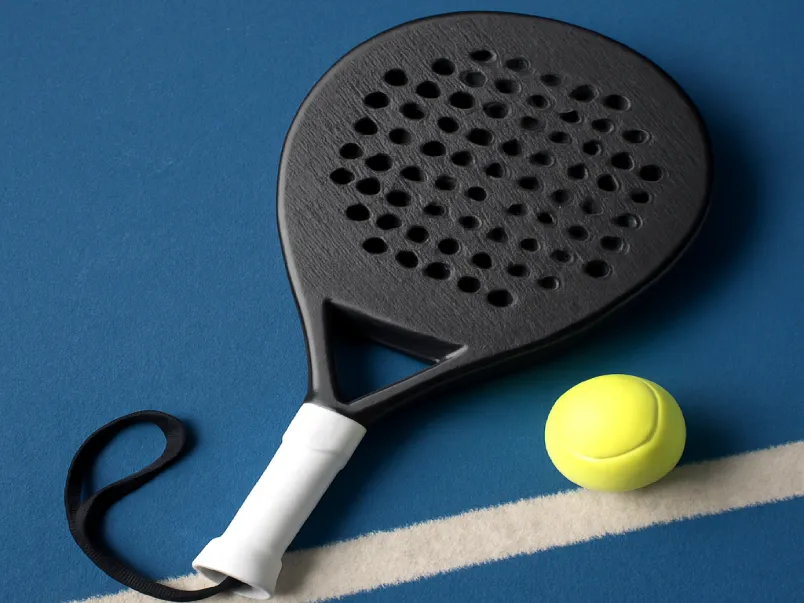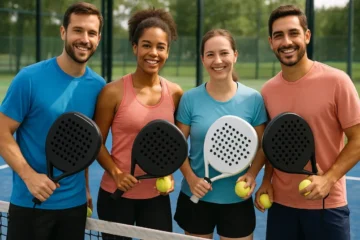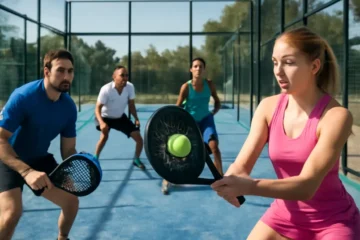Padel is one of the fastest-growing sports in the world, and it’s no surprise why—its fast-paced nature, strategic gameplay, and social atmosphere make it both challenging and fun. If you’ve caught the padel bug, you’re likely looking to level up your game with better equipment, and there’s no piece of gear that screams “upgrade” like a high-performance carbon padel racket.
But, with the price of carbon rackets often much higher than their fiberglass counterparts, you may be left wondering if the investment is truly worth it. You’ve probably heard teammates or fellow players raving about the power and control that come with carbon rackets, and it’s tempting to jump on the bandwagon. However, before pulling the trigger, it’s important to assess whether a carbon racket fits your playing style, goals, and budget.
In this article, we’ll break down the benefits, drawbacks, and key considerations surrounding carbon padel rackets, helping you make an informed decision about whether it’s time for an upgrade.
I. The Allure of Carbon
Let’s start with a scenario: You’re an intermediate player who has mastered the basics of padel and feels that your beginner racket is holding you back. You hear your teammates discuss the “power” and “control” of their carbon rackets, and you can’t help but feel intrigued. Maybe you’ve seen those sleek, black rackets in the pro player’s hands and imagined yourself wielding one. But there’s one question on your mind: is the upgrade worth it?
In short: It depends. There’s no universal answer because the right racket for you depends on your playing style, skill level, and goals. This article will help you understand whether a carbon racket fits your needs and whether it’s worth the significant price jump.
II. What Makes Carbon So Special? Understanding the Material
Before diving into the pros and cons of carbon padel rackets, let’s first understand what sets them apart from other materials.
Padel rackets are primarily made from composites—materials that combine the strengths of different substances. The most common materials used are fiberglass and carbon fiber, each offering unique characteristics:
- Fiberglass: This material is flexible, forgiving, and offers great power, making it an ideal choice for beginners who need help with ball control. Fiberglass is often used in rackets designed for players who are still developing their technique.
- Carbon Fiber: In contrast, carbon fiber is much stiffer, stronger, and more rigid. It offers the best power and control, making it the premium choice for intermediate to advanced players.
The key property that makes carbon fiber so desirable in padel rackets is its high stiffness-to-weight ratio. This means that the racket can be extremely rigid without being heavy, allowing for greater energy transfer from your swing to the ball. This results in more explosive shots and better overall control.
III. The Advantages of Carbon Rackets (The “Worth It” Argument)
Now that we understand the material, let’s dive into the main benefits of a carbon racket and why it might be a worthy investment for the right player.
1. Superior Power and Explosiveness
One of the key advantages of carbon rackets is their ability to generate power. The stiffness of the carbon frame means that less energy is lost during the ball’s impact. Unlike fiberglass rackets, which tend to flex and “bend” during impact (known as the “trampoline effect”), carbon rackets provide a solid, responsive feel.
This allows the ball to “pop” off the racket with more pace, making it easier to hit smashes, volleys, and other power shots. For advanced players who rely on speed and power, a carbon racket can help take their game to the next level.
2. Enhanced Control and Precision
While power is important, control is equally crucial—especially for players who want to finesse their shots. Carbon rackets offer superior control thanks to their rigidity. The lack of flex gives you a more direct, predictable feel, allowing for greater precision on shots like bandejas, viboras, and drop shots.
With a carbon racket, advanced players can “place” the ball more accurately, giving them the ability to control where the ball lands with greater ease. This is ideal for players who focus on strategy and shot placement rather than just brute force.
3. Improved Reactivity at the Net
At the net, quick reflexes are essential. Carbon rackets excel in fast-paced exchanges because their stiff frames allow for quick, reactive blocks and volleys. The reduced vibration and solid construction of the racket make it easier to respond to fast shots with confidence, especially in high-stakes moments during competitive matches.
4. Durability and High-End Feel
Another reason carbon rackets are so appealing is their durability. Carbon fiber is known for being exceptionally strong and resistant to impact, meaning it can withstand the rigors of intense play without showing significant wear. This is particularly important for competitive players who train regularly and need reliable gear that can keep up with their demands.
In addition, many players find that carbon rackets offer a premium, solid feel in their hands. The weight distribution and feel of the racket contribute to an overall sense of quality and professionalism that many serious players appreciate.
IV. The Drawbacks and Considerations (The “Not For Everyone” Argument)
As with any high-end product, carbon rackets come with a few drawbacks. While they are undoubtedly powerful, they may not be the best choice for every player. Here are a few things to keep in mind:
1. The Significant Cost
The biggest barrier to entry for carbon rackets is their price. Because carbon fiber is a premium material, rackets made with carbon are significantly more expensive than fiberglass models. For recreational or casual players, this may not be a justified expense, especially if you’re just getting started with padel or don’t play frequently.
2. Less Forgiving on Mishits
One of the downsides of carbon rackets is that they are less forgiving on mishits. Since the material is stiffer, there’s less dampening of vibrations when you hit off-center shots. This can make off-center hits feel harsh and cause more strain on your arm. For beginners or players who don’t have consistent technique, this lack of forgiveness could actually hinder performance and cause discomfort.
3. Demands a Higher Skill Level
To get the most out of a carbon racket, you need to have a consistent and controlled technique. The power and stiffness of the racket can be a liability for beginners, who may struggle to control the ball or generate accurate shots. Carbon rackets are designed for players who already have a solid foundation in their technique and are looking to elevate their game.
4. Potential for Arm Discomfort
Another consideration is the potential for arm discomfort. Players who are prone to tennis elbow or other arm-related injuries may find that the stiff feel of a carbon racket exacerbates these issues. If you have a history of arm pain, it may be worth considering a racket with a softer core, such as one made with fiberglass or a carbon-fiber/fiberglass mix.
V. Who Are Carbon Rackets REALLY For?
So, who should invest in a carbon racket? Let’s break it down:
The Ideal Candidate:
- Aggressive Intermediate/Advanced Players: If you’ve developed consistent technique and are looking for a racket that can provide more power and control, a carbon racket may be the perfect fit. Carbon is ideal for players who need a stiff, responsive racket to match their playing style.
- Net Dominators: Players who focus on net play, quick volleys, and reflexive blocks will appreciate the reactivity and solid feel of a carbon racket.
- Competitive Players: For players who compete in tournaments or league matches, the extra power and precision offered by a carbon racket could give you a competitive edge.
Who Should Think Twice:
- Beginners: If you’re just starting with padel, a carbon racket is probably not the best choice. A fiberglass racket will offer more forgiveness, making it easier to develop your technique without the risk of arm discomfort.
- Players with Arm Injuries: If you suffer from tennis elbow or other arm-related issues, you may want to avoid a stiff carbon racket. Consider a racket with a softer core or one that blends carbon and fiberglass for a more comfortable feel.
- Recreational Players: If you only play casually and don’t invest significant time or money in the sport, the premium price of a carbon racket may not be justifiable. A more affordable option will likely meet your needs just fine.
VI. It’s Not Just “Carbon” – Understanding the Blends
It’s important to note that not all carbon rackets are made entirely of carbon. Many rackets use a blend of carbon and fiberglass to strike a balance between power, control, and forgiveness. These blended rackets can offer many of the benefits of carbon while providing a softer feel that may be more forgiving on off-center hits. For players transitioning from beginner to intermediate levels, these mixed-material rackets are a great “gateway” option.
VII. Final Verdict: Weighing the Investment
So, are carbon rackets worth the investment? The answer is, in many ways, dependent on your playing level and goals.
- YES, if you are a committed player with solid fundamentals and play regularly. The performance upgrade can be significant, offering more power, control, and precision, all of which can take your game to the next level.
- NO, if you are a beginner, casual player, or have budget constraints. The drawbacks of cost, lack of forgiveness, and potential arm discomfort may outweigh the benefits for players who are still developing their skills.
In conclusion, a carbon padel racket is a tool for a specific job. It won’t fix flawed technique, but for the right player, it can unlock a whole new level of performance. Consider it a worthy investment when your skills have outgrown your beginner racket and you’re ready to make the leap to a more advanced level of play.
FAQs: Carbon Padel Rackets
1. Are carbon padel rackets worth the investment for beginners?
No, carbon rackets are typically not ideal for beginners. They are stiffer and less forgiving than fiberglass rackets, making it harder for beginners to develop their technique. A fiberglass or composite racket is generally a better option for newcomers to the game.
2. What is the main advantage of carbon fiber in padel rackets?
The main advantage of carbon fiber is its stiffness-to-weight ratio. This allows for powerful shots and better control without making the racket too heavy. Carbon rackets provide more explosiveness, control, and durability compared to fiberglass rackets.
3. How much do carbon padel rackets typically cost?
Carbon padel rackets are usually more expensive than their fiberglass counterparts. Prices can range from $150 to over $400, depending on the brand and the racket’s design and features. The cost is primarily driven by the high-quality carbon material used in their construction.
4. Can carbon rackets cause arm discomfort?
Yes, carbon rackets can potentially cause arm discomfort, especially for players prone to conditions like tennis elbow. The stiff frame of carbon rackets can transmit more shock on off-center hits, leading to discomfort. Players with arm issues should consider rackets with softer cores or a combination of carbon and fiberglass.
5. Who should consider using a carbon padel racket?
Carbon rackets are ideal for intermediate and advanced players who have developed a consistent technique and want more power, precision, and control. They are also great for competitive players and those who frequently play at the net and need explosive reactions.
6. What is the difference between a full carbon racket and a carbon/fiberglass blend?
A full carbon racket provides maximum stiffness and power, making it suitable for players with advanced skills. A carbon/fiberglass blend offers a balance of power and forgiveness, providing a softer feel while retaining the benefits of carbon. These blended rackets are often a good choice for intermediate players transitioning to more advanced equipment.
7. Do carbon rackets help with control?
Yes, the rigidity of carbon rackets provides superior control. This allows players to place the ball more accurately and execute precise shots, such as bandejas or viboras, with ease.




